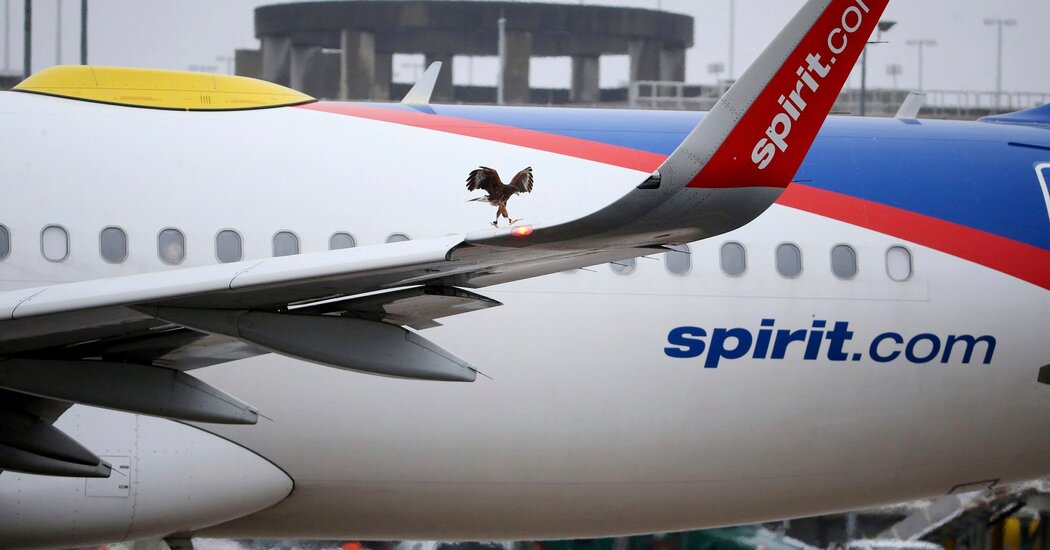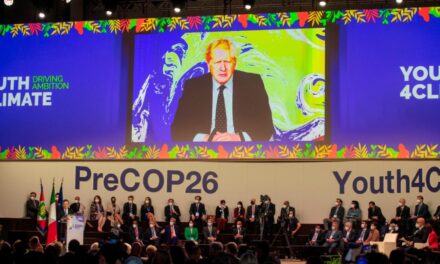
Business Updates: Frontier and Spirit Airlines Announce Plans to Merge

Image


Spirit Airlines and Frontier Airlines, two prominent U.S. budget carriers, announced Monday that they had agreed to merge, a combination that would create the nation’s fifth-largest airline by market share and put pressure on the nation’s biggest carriers as the industry seeks to shake itself of the pandemic.
The airlines, which together offer 1,000 daily flights serving destinations in the United States, the Caribbean and Latin America, said in a statement they would achieve $1 billion in annual savings from combining, without layoffs. They also said they expected to add 10,000 direct jobs by 2026 and create thousands more through their business partners.
They said the merger was expected to close in the second half of the year, subject to regulatory review and approval of Spirit shareholders. Frontier’s parent company, Frontier Group Holdings, in which the private equity company Indigo Partners has a controlling interest, has approved the deal.
Under the merger agreement, Frontier equity holders would control 51.5 percent of the combined company, and Frontier would name seven of 12 board members. The board would be headed by William A. Franke, the chairman of Frontier and the managing partner of Indigo Partners, a private equity firm that specializes in investing in budget airlines. The companies said branding would be decided before the merger closes.
Mr. Franke served as chairman of Spirit from 2006 to 2013. Indigo played a key role in helping to take Spirit public in 2011 and Frontier public last year. It has also advised and invested in Tigerair in Singapore, Volaris in Mexico and Wizz Air in Europe.
When Frontier went public last spring, the airline said it stood out among budget carriers. Spirit serves more-crowded markets and Allegiant Air serves less-crowded ones, but Frontier is more evenly distributed, it said at the time.
The combined airline would fly mostly within the United States, but also to destinations in Latin America and the Caribbean. Spirit operates three times as many international flights as Frontier, according to Cirium, an aviation data provider.
The companies say the merger will benefit consumers, allowing them to sell cheaper tickets and offer better service. In November, the average price of a domestic ticket sold by Spirit was $109, before taxes and fees, compared with $73 for Frontier.
The merger could face pushback from the Biden administration, which has increasingly challenged such deals in court, arguing that they reduce competition and raise prices. In the fall, the Justice Department sued to prevent a domestic alliance between American Airlines and JetBlue Airways. As it stands, the nation’s four largest airlines collectively control about 80 percent of the domestic air market.
Shares in Spirit jumped in premarket trading, though they remained below Frontier’s bid of $25.83 per share, implying some skepticism that the transaction will go through.
That said, shares in other airlines were up on the news, which is not usually how shares of competitors react to the potential entry of a “disruptive” new challenger. It’s another sign that Frontier and Spirit could face a challenge in convincing regulators that their merger would actually lead to stiffer competition and lower prices.
The combined airline would have annual revenue of approximately $5.3 billion based on 2021 results, the announcement said.
Michael J. de la Merced contributed reporting.
Image

The White House on Monday released a report outlining several dozen steps it intends to take to promote union membership and collective bargaining among both public and private sector employees.
The report is the product of a task force that President Biden created through an executive order in April. A White House statement said the president had accepted the task force’s nearly 70 recommendations.
Many of the steps would make it easier for federal workers and employees of contractors to unionize, including ensuring that union organizers have access to employees on federal property, which does not always happen today.
The report also recommends creating preferences in federal grant and loan programs for employers who have strong labor standards, preventing employers from spending federal contract money on anti-union campaigns and making employees aware of their organizing rights.
When the task force was created, some White House officials indicated that they supported considering labor union membership as a factor in awarding government contracts, but the task force recommendations generally did not emphasize this approach.
Under federal procurement law, the government generally cannot deny contracts to companies it deems hostile to labor unions. But it may be able to consider a company’s posture toward unions as a factor in certain narrow cases — for example, when labor strife resulting from an aggressive anti-union campaign could substantially delay the provision of some important good or service.
The executive order Mr. Biden signed creating the task force required it to submit recommendations within 180 days, at which point the president would review them.
One key premise of the task force was that the National Labor Relations Act, the 1935 law that protects federal labor rights, explicitly encourage collective bargaining, and yet, according to the Biden White House, no previous administration had explored ways that the executive branch could do so systematically.
The ambition of the task force was twofold: to enact policies for federal agencies and contractors that encourage unionization and to model best practices for employers in the public and private sectors.
The president’s task force will submit a second report describing progress on its recommendations and proposing additional ones in six months.
Union officials and labor experts consider Mr. Biden to be among the most pro-labor presidents ever. He moved quickly to oust Trump appointees viewed as unsympathetic to labor and to undo Trump-era rules that weakened protections for workers, and signed legislation that secured tens of billions of dollars to stabilize union pension plans.
Mr. Biden has occasionally used his bully pulpit to urge employers not to undermine workers’ labor rights or bargaining positions, as when he warned against coercing workers who were weighing unionizing during a prominent union election at Amazon last year. He later called Kellogg’s plan to permanently replace striking workers “an existential attack” on its union members.
Last week, Mr. Biden signed an executive order requiring so-called project labor agreements — agreements between construction unions and contractors that set wages and working conditions — on federal construction projects worth more than $35 million, a move that the White House estimates could affect nearly 200,000 workers. He had previously signed an executive order raising the minimum wage for federal contractors to $15 per hour from $10.95.
But despite Mr. Biden’s backing, and polls showing widespread public support for unions, the rate of union membership nationwide remains stuck at a mere 10 percent, its lowest in decades.
The Protecting the Right to Organize Act, or PRO Act, which Mr. Biden supports, would make it easier to unionize by preventing companies from holding mandatory anti-union meetings and imposing financial penalties on employers that retaliate against workers seeking to unionize. It passed the House in March but remains a long shot in the Senate. Democrats may seek to pass some of its provisions along party lines this year.
Image
Tuesday
-
Pfizer earnings: The pharmaceutical giant will publish its quarterly financial report for the three months ending in December. Investors will be watching for updates on Pfizer’s revenue and production expectations for Paxlovid, the company’s oral antiviral pill for Covid-19, as well as for its coronavirus vaccine.
-
Trade deficit report: The Commerce Department is set to publish data on the nation’s international trade deficit. Economists will get a better understanding of how congestion at ports and warehouses, which has caused delays in global shipping, is curbing economic growth.
Wednesday
-
Disney earnings: Investors will be watching to get a better idea of subscriber growth at the end of last year for the Disney+ streaming service, which did not grow as quickly as expected in the fall. Netflix said in January that it expected a slowdown in subscriber growth for 2022.
-
Uber earnings: Uber’s investment in the Chinese company Didi has hampered its bottom line amid China’s crackdown on big tech companies. Still, revenue in the last three months of 2021 is expected to be higher than it was a year earlier, as people spent more time out and businesses continued to reopen.
Thursday
-
Consumer Price Index: The latest report on inflation from the Labor Department is expected to show that consumer prices kept climbing in January, in part because of continued supply chain disruptions. Economists expect prices rose about 7.3 percent from a year earlier, giving the Federal Reserve more incentive to raise interest rates several times this year as it tries to get inflation under control by slowing growth.
-
Coca-Cola, PepsiCo and Kellogg earnings: Three food giants will provide details on how supply chain bottlenecks during the last three months of 2021 affected profits. Several companies, including Procter & Gamble and Nestlé, have already announced that they will raise prices to offset higher costs.
-
Twitter earnings: After Meta’s disappointing quarterly earnings report, investors will find out how Twitter’s ad business fared at the end of last year. Social media companies are grappling with an update by Apple that made it harder for apps to track iPhone users’ digital habits, affecting the ability of social networks to target ads.
Friday
-
Consumer sentiment: The University of Michigan will publish preliminary results for its consumer sentiment index, which measures how Americans feel about the economy. January’s numbers showed that consumer sentiment fell to its lowest level since November 2011 as inflation continued to rise. The Federal Reserve watches the report as a measure of inflation expectations.
Image

A growing chorus of voices — from the prime minister of Denmark to President Biden’s former pandemic advisers — is calling for a change in approach to the coronavirus, to accept it as a part of everyday life to be managed, not a deadly scourge requiring lockdowns and stringent preventive measures.
That message has been resonating in the world of travel and among industry representatives, who frequently borrow a public health term to make their case to ease travel restrictions.
“When I use the word pandemic, I think of the two years where we sheltered in place, but endemic is very similar to what I’m doing now — traveling for business as an entrepreneur, but also for vacation and seeing friends and family that I’ve missed,” said Jennifer Wilson-Buttigieg, a co-president of Valerie Wilson Travel, a New York-based travel consulting company.
A possible shift in mind-set has given the travel industry in Europe and the United States a boost in recent weeks, as have the increasing numbers of travelers booking spring and summer trips.
In a bimonthly travel sentiment survey taken in mid January by Longwoods International, a travel market research firm, of 1,000 Americans who traveled for business or pleasure before the pandemic, 91 percent of respondents have travel plans in the next six months, and 25 percent said that the pandemic is no longer influencing their decision to travel.
In data recorded last week and to be released Tuesday, said Amir Eylon, president and chief executive of Longwoods International, 31 percent of respondents reported that the pandemic is no longer influencing their decision to travel.
This comes after domestic leisure travel had a strong year in 2021, rebounding well after extraordinary losses in 2020, according to the U.S. Travel Association, a trade group that promotes travel to and within the United States.
But in the United States, some experts say a shift in mind-set — however desired — is premature. The Omicron surge has begun to level off in some states, but case numbers and hospitalizations remain extremely high across the country.
But many Americans who are looking to book international travel this year are worried less about the virus itself and more about the prospect of getting stuck overseas, with a positive test result prohibiting them from flying back to the United States.
The Centers for Disease Control and Prevention has also issued its highest level four “do not travel” warning for many popular destinations abroad, sparking hesitation among some consumers.
Image
For the past few months, those Americans who had been lucky enough to find at-home coronavirus tests in stores had been kept from buying more than a few at a time so that stores could keep up with the surging demand.
But that is changing at nearly all CVS and Walgreens locations nationwide as of this week. A CVS spokesman, Matthew Blanchette, confirmed on Saturday that the pharmacy chain had increased its inventory of over-the-counter rapid test kits and removed all limits “on those products at CVS Pharmacy locations nationwide and on CVS.com.”
A Walgreens representative also said on Saturday that because of “improved in-stock conditions,” the company had removed its purchase limit of at-home tests at almost all its locations.
Both companies announced in late December that they would cap the number of tests bought in stores and online to keep up with demand as the highly contagious Omicron variant spread. CVS said it would allow the purchase of only six tests per person; Walgreens would allow only four. And still, many consumers regularly found empty store shelves when shopping for test kits.
The issue of testing shortages in the United States has persisted since the beginning of the pandemic, revealing just how much the Biden administration has struggled to meet demand as it has largely focused on getting people vaccinated.
Last month, the administration unveiled a website where Americans could order four free at-home tests per household through the Postal Service. The White House said that it had already mailed out tens of millions of tests. But the delivery schedule has been patchy, with some receiving their tests right away while others are still waiting.
In the latest federal effort to deliver more rapid tests, the Centers for Medicare and Medicaid Services said this week that Medicare, which covers roughly 60 million Americans, would provide free kits beginning in “early spring.”
Enrollees, most of whom are 65 or older, will be able to get up to eight tests per month, the same number covered for privately insured Americans as part of new requirements announced in January.
While the Omicron-driven surge may be showing signs of waning in many parts of the country, the tests could help Medicare recipients, some of the most vulnerable Americans, in possible future surges.
Image
By now, the Omicron wave of the coronavirus has crested in much of the United States. But the size of the wave, which broke records for national cases and hospitalizations, has given regulators and scientists an opportunity to better assess vaccine efficacy in children ages 6 months to 4 years old, Dr. Scott Gottlieb, a former commissioner of the Food and Drug Administration, said on Sunday.
Dr. Gottlieb, who sits on the board of the vaccine maker Pfizer, said that he hopes key data expected on Friday will shed additional light on whether the federal government should grant emergency authorization for two doses of Pfizer-BioNTech’s vaccine for children in this age group.
“We now have an opportunity to look at a much richer data set,” Dr. Gottlieb said on CBS’s “Face The Nation.” He did not specify what that data would reveal. Still, he emphasized that the toll Omicron took on children in particular gave Pfizer a stronger basis for comparison of those given vaccines and those not.
“Some got infected, hopefully some didn’t,” he said of the test group. “I think that’s what the data package is going to show, and I think it’s going to give a much clearer picture of” the vaccine’s efficacy against Omicron.
He said that the newer data would help illuminate results that had been less rich before the full Omicron wave had crested.
At the urging of the federal government, Pfizer and its partner BioNTech applied last week for authorization for two doses of its vaccine to children 4 and younger.
But results released in December did not show the hoped-for immune response in children ages 2 to 4. Children 6 months to 2 years old showed a comparable response to that of older teenagers and young adults.
The disappointing finding has led the companies to test a third shot in young children, but those results will not available for a few weeks. Still, in hopes of getting a jump start on the vaccination effort, the F.D.A. urged the companies to apply for authorization of two doses while everyone awaits data on the third dose.
The thinking is that if two doses are authorized and given, then children would be prepared for a third dose if and when research demonstrates that three shots prove fully effective.
That three doses will work is the working presumption of Pfizer and of some experts. Critics have argued that this strategy is short-circuiting the research process and that there is not yet clear evidence that a third dose will be make up for the inadequacies of two doses.
The full data on the trials have not been made public. But one person familiar with Pfizer’s research, who spoke on condition of anonymity, told The New York Times recently that children 6 months to 2 years old who received two doses became infected at a 50 percent lower rate than a placebo group, while children 2 to 4 years old became infected at a 57 percent lower rate.
Dr. Vivek Murthy, the surgeon general, said last week said no corners would be cut with Pfizer’s application for emergency authorization of the vaccine in young children. The application, he said, would “undergo the same independent, rigorous and transparent review process” that was used to clear the vaccine for adults. He also cited the role of the Omicron surge and its impact on children.
“Whether that changes the risk-benefit profile is what the F.D.A. will be assessing,” Dr. Murthy said. “But there has been developments since December on the data front.”
Image

Only two of the 190 athletes and team officials who arrived at the Beijing airport tested positive for the coronavirus on Saturday, a steep decline from Friday when 20 were forced to isolate.
An additional two people tested positive among other attendees, a group that includes international journalists. There were 305 total arrivals.
All arrivals to Beijing must undergo a polymerase chain reaction, or P.C.R., test at the airport and then isolate in hotel rooms until the results come back a few hours later. Those who test negative are allowed to move freely throughout the Games’ so-called closed loop system, which restricts athletes and others involved with the Olympics to designated hotels and venues. The closed loop is designed to keep the virus from spreading to the rest of China, which has tried to eradicate Covid from its general population.
All Olympic attendees undergo a P.C.R. test every day. Of the 72,481 tests taken in the closed loop on Saturday, six people tested positive, including four athletes and team officials.
Those who test positive but do not require medical treatment must isolate in hotel rooms, and they are allowed to return to action only after registering two negative tests.
Note: Data is shown by the date in Beijing when a case was announced, and it includes athletes, team officials and other staff members and stakeholders. Those who have tested positive before their departure to the Games are not included in the chart above.
Athletes Who Have Tested Positive for the Coronavirus
This table includes athletes who tested positive before traveling to China. Some athletes who have tested positive have not been publicly identified, and some who test positive can be cleared later to participate in the Games.
|
Feb. 3 |
Casey Dawson United States |
Speedskating |
United States |
Before arriving |
|
Cestmir Kozisek Czech Republic |
Ski jumping |
Czech Republic |
In China |
|
|
David Krejci Czech Republic |
Ice hockey |
Czech Republic |
In China |
|
|
Viktor Polasek Czech Republic |
Ski jumping |
Czech Republic |
In China |
|
|
Jarl Magnus Riiber Norway |
Nordic combined |
Norway |
In China |
|
|
Ivan Shmuratko Ukraine |
Figure skating |
Ukraine |
In China |
|
|
Feb. 2 |
Matthias Asperup Denmark |
Ice hockey |
Denmark |
In China |
|
Olena Bilosiuk Ukraine |
Biathlon |
Ukraine |
In China |
|
|
Nick Olesen Denmark |
Ice hockey |
Denmark |
In China |
|
|
Nolan Seegert Germany |
Figure skating |
Germany |
In China |
|
|
Feb. 1 |
Elana Meyers Taylor United States |
Bobsled |
United States |
In China |
|
Jan. 31 |
Audrey King Hong Kong |
Alpine skiing |
Hong Kong |
In China |
|
Jan. 29 |
Tahli Gill Australia |
Curling |
Australia |
In China |
|
Marita Kramer Austria |
Ski jumping |
Austria |
Before arriving |
|
|
Jan. 28 |
Natalia Czerwonka Poland |
Speedskating |
Poland |
In China |
|
Magdalena Czyszczon Poland |
Speedskating |
Poland |
In China |
|
|
Marek Kania Poland |
Speedskating |
Poland |
In China |
|
|
Zan Kosir Slovenia |
Snowboard |
Slovenia |
In China |
|
|
Jan. 26 |
Anne Kjersti Kalva Norway |
Cross-country skiing |
Norway |
Before arriving |
|
Vasily Kondratenko Russian Olympic Committee |
Bobsled |
Russian Olympic Committee |
Before arriving |
|
|
Sinja Leemann Switzerland |
Ice hockey |
Switzerland |
Before arriving |
|
|
Alina Müller Switzerland |
Ice hockey |
Switzerland |
Before arriving |
|
|
Aleksei Pushkarev Russian Olympic Committee |
Bobsled |
Russian Olympic Committee |
Before arriving |
|
|
Heidi Weng Norway |
Cross-country skiing |
Norway |
Before arriving |
|
|
Josh Williamson United States |
Bobsled |
United States |
Before arriving |
|
|
Jan. 25 |
Mikhail Kolyada Russian Olympic Committee |
Figure skating |
Russian Olympic Committee |
Before arriving |
|
Nikita Tregubov Russian Olympic Committee |
Skeleton |
Russian Olympic Committee |
Before arriving |
|
|
Adam Vaclavik Czech Republic |
Biathlon |
Czech Republic |
Before arriving |
|
|
Alex Varnyu Hungary |
Short-track speedskating |
Hungary |
Before arriving |
|
|
Jan. 24 |
Shaoang Liu Hungary |
Short-track speedskating |
Hungary |
Before arriving |
|
Jan. 22 |
Andreas Wellinger Germany |
Ski Jumping |
Germany |
Before arriving |
|
Jan. 7 |
Alysa Liu United States |
Figure skating |
United States |
Before arriving |
|
Shaun White United States |
Snowboard |
United States |
Before arriving |
|
|
Dec. 20 |
Alice Robinson New Zealand |
Alpine skiing |
New Zealand |
Before arriving |
Source: https://www.nytimes.com/live/2022/02/07/business/stock-market-economy-news


















